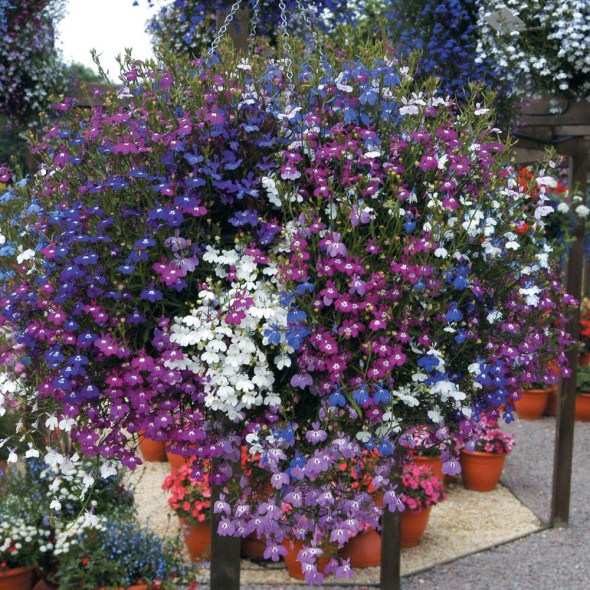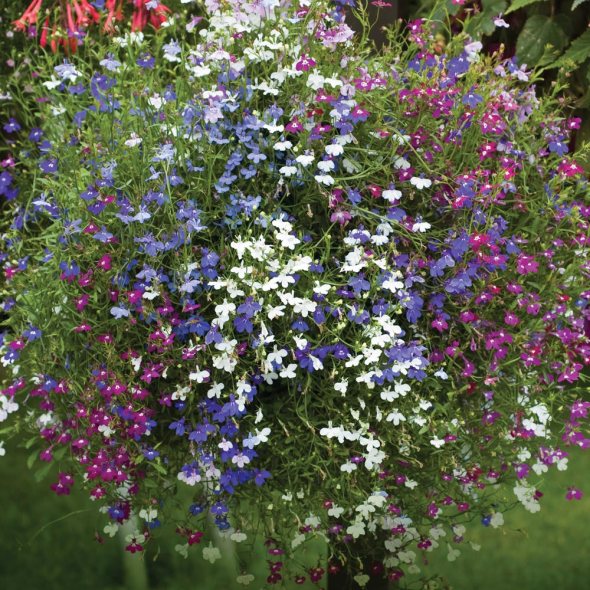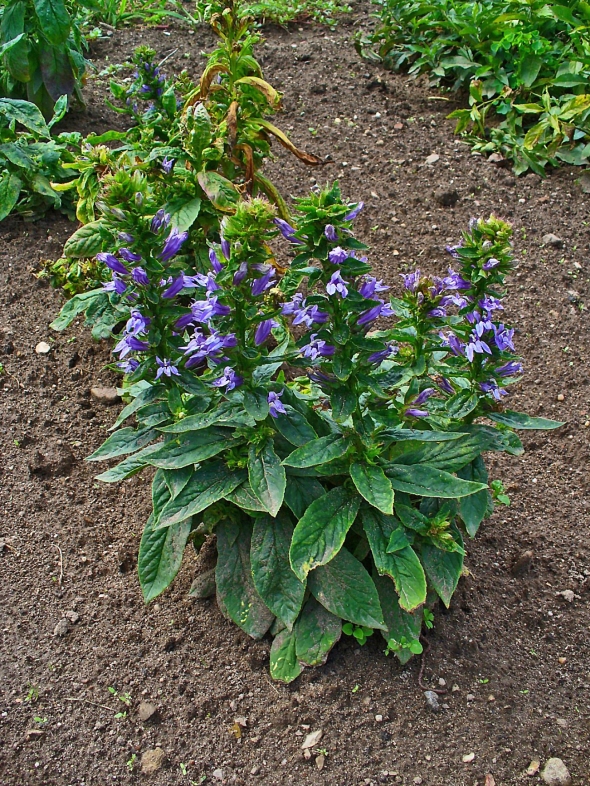Lobelia Plant Care Guide and Varieties
side note this is one of my must haves for window boxes, borders, and hanging baskets … was thinking of putting some in container with eggplant plant, think they would look great together. Warning this plant is poisonous …
Overview
A family of well-cultivated species in a variety of colors, sizes and seasonal growth patterns, lobelia offers something for every gardener to enjoy. From tall spikes bearing scarlet red blooms to trailing, low-mounding bright blue buds, lobelia also comes in white, pink, and purple shades of flowers. Whether you choose a perennial species like Lobelia cardinalis or L. siphilitica, or annual species L. erinus, growing requirements vary little.
Site
All lobelia, whether annual or perennial, prefer partial shade. When choosing a site, be sure that the area will have at least partial shade for most of the day and protection from the harshest mid-day sunshine for best results.
Soil
Most lobelia planting beds need additional organic matter, such as composted leaves or manure, to improve drainage and add nutrients. Till up to 3 inches of organic matter up to 8 inches deep into the soil prior to planting.
Water
Keep soil moist to improve lobelia plant size and health, and to encourage blooming. Annuals require up to 1 1/2 inches of water per week, according to Clemson University Cooperative Extension experts. Perennials should be watered less frequently and deeply to encourage root establishment for subsequent seasons. Allow the topsoil to dry completely between waterings.
Fertilizer
A 10-10-10 balanced fertilizer should be applied and thoroughly combined with the soil at a rate of 1 lb. per 100 square feet at the time of bed preparation. Additional fertilizer may be applied, in liquid form, to improve annual growth or bloom as needed.
Winter Care
Provide an organic mulch cover, such as composted pine needles, around perennial plants as fall approaches to protect root systems over the winter. Perennial species of lobelia can be cut back to just above ground level after blooming has ceased.
How to Grow Lobelia Erinus
Instructions
side note here Lobelia can be started easily from seeds …….
-
- 1
Buy healthy, green plants in spring with no signs of wilting or disease. Plants should be stocky with plenty of leaves. It’s actually a plus if they don’t have any flower on them so that they’ll divert their early energy into root development rather than flowering.
- 2

Plant lobelia seedlings in spring, a week or two before your season’s last frost date, in a spot where they’ll get full sun to very light shade. They appreciate a little afternoon shade.
- 3
Work a little compost into the planting soil. Lobelia likes rich soil high in organic matter.
- 4
- 5
- 6
Pull out and discard plants once heavy frost kills them in autumn.
Tips & Warnings
- When summer’s heat or humidity causes lobelia to stop blooming, just shear the plants back by half. As long as you keep the soil moist, they’ll bloom again when cooler weather hits.
- Don’t allow lobelia plants to dry out. They need ample moisture and die easily without steady water.
******************See Also ……
Native Plant Database ~ Great Blue Lobelia Wildflower
Lobelia L.
Lobelia~ Growing Guide Cornell
Perennial and Annual Lobelia Attract Butterflies and Hummingbirds
Lobelia erinus ~ Learn to Grow
just some of the Lobelia species ~ Click here for more
Selected species
- Lobelia aberdarica R.E. & T.C.E.Fries (Kenya and Uganda)
- Lobelia anatina F.Wimmer – Southwestern blue lobelia
- Lobelia anceps L.f.
- Lobelia appendiculata A.DC
- Lobelia arnhemiaca E.Wimm (Western Australia)[23]
- Lobelia assurgens L.
- Lobelia bambuseti
- Lobelia berlandieri A.DC.
- Lobelia boykinii Torr. & A.Gray ex A.DC.
- Lobelia canbyi A.Gray
- Lobelia cardinalis L. (syn. L. fulgens) – cardinal flower (Americas)
- Lobelia chinensis Lour. – Chinese: 半边莲; pinyin: bàn biān lián (East and South Asia)
- Lobelia collina Kunth (Ecuador)
- Lobelia comosa
- Lobelia coronopifolia
- Lobelia deckenii Hemsl. (Eastern Africa)
- Lobelia dentata Cav. (Eastern Australia)
- Lobelia dortmanna L. (Northern North America and Europe)
- Lobelia erinus L. – edging lobelia (Southern Africa)
- Lobelia flaccidifolia Small
- Lobelia flaccida
- Lobelia gaudichaudii A.DC (island of Oʻahu in Hawaii)
- Lobelia gerardii
- Lobelia gibberoa Hemsl.
- Lobelia heterophylla Labill.
- Lobelia hypoleuca Hillebr. – Kuhiʻaikamoʻowahie (Hawaii)
- Lobelia ilicifolia (syn. L. purpurascens) – purple lobelia
- Lobelia inflata L. – Indian tobacco (Eastern North America)
- Lobelia kalmii L. (Northern North America)
- Lobelia laxiflora Kunth – Sierra Madre Lobelia
- Lobelia leschenaultiana (C.Presl) Skottsb.
- Lobelia monostachya (Rock) Lammers (island of Oʻahu in Hawaii)
- Lobelia nicotianifolia
- Lobelia niihauensis H.St.John (islands of Hawaii)
- Lobelia oahuensis Rock (island of Oʻahu in Hawaii)
- Lobelia persicifolia Lam.
- Lobelia pratioides Benth. – poison lobelia (Australia)
- Lobelia pinifolia
- Lobelia puberula Michx.
- Lobelia pyramidalis Wall.
- Lobelia rhombifolia de Vriese
- Lobelia rosea Wall. ex Roxb.
- Lobelia sessilifolia Lamb.
- Lobelia siphilitica L. (Eastern and Central North America)
- Lobelia spicata Lam.
- Lobelia telekii Scwheinf (mountains of Uganda and Kenya)
- Lobelia tenuior R.Br.
- Lobelia thapsoidea Schott (Southeastern Brazil)
- Lobelia tupa L. (Central Chile)
- Lobelia urens L. (heath lobelia)
- Lobelia valida L.Bolus
- Lobelia zeylanica L.[24][25]
2 responses
Leave a comment
- 3
- 1












my hanging blue lobelia plant has dried out leaves. why? did I overwater or underwater?
June 7, 2014 at 7:30 pm
Cut your lobelia back by a half and keep a regular watering schedule. We tend to kill our plants with kindness because we want to give them extra water when they look sick. Same with pansies and petunias when they get leggy, cut them back.
June 10, 2014 at 1:39 am